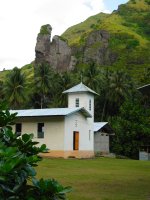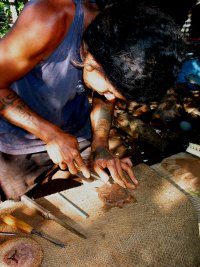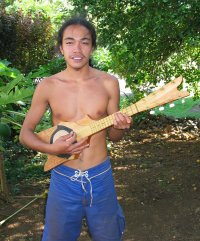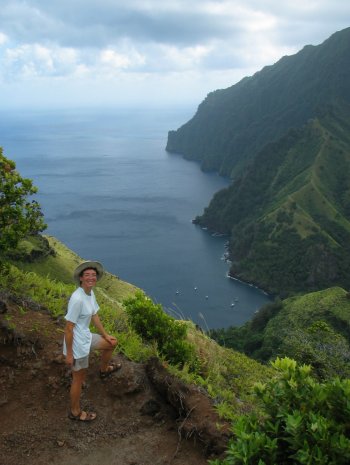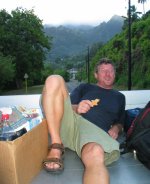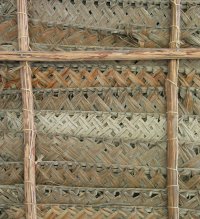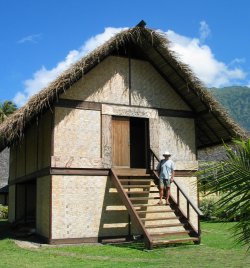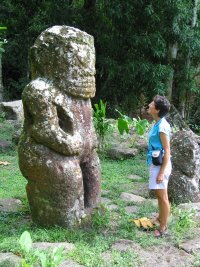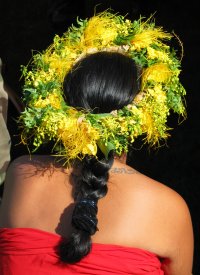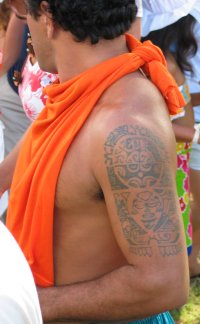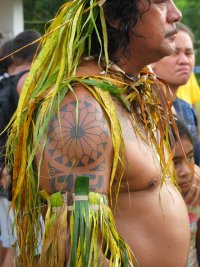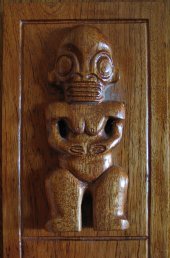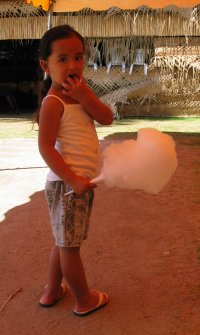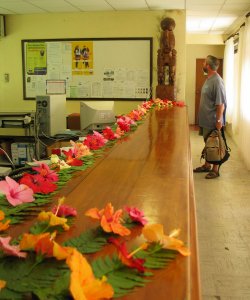 Marquesas
- June/July 2005
Marquesas
- June/July 2005
|
We spent a month in the Marquesas, visiting four islands: Fatu Hiva, Hiva Oa, Tahuata and Ua Pou. This was our first time in Polynesia and we loved it - dramatic and beautiful unspoilt islands and friendly people. We would love to visit again. Now for a quick geology lesson. Did you know that the Pacific islands were nearly all once volcanoes? This is how they formed: A crack opens in the earth's mantle and volcanic magma escapes upwards. A submarine volcano builds up slowly until the lava finally breaks the sea surface, becoming a volcanic island. Over time the volcano and the tectonic plate on which it sits move away from the "hot spot" of magma in the earth's mantle from which it emerged. Also over time the volcano subsides slowly under its own weight, while suffering erosion by the sea, wind and rain. In warmer waters of the Pacific, such as around the Tuamotus and Society Islands, coral reefs begin to grow along the shores. As the island continues to subside the reefs continue to grow upwards resulting in a lagoon between the reef and the shoreline. Ultimately, as in the case of the Tuamotus, if the volcanic core disappears under the lagoon, the remaining reef island is called an atoll. In the case of the Marquesas, the cold south equatorial current does not favour large coral reefs, although there are some small isolated stretches of coral. Thus the dramatic skylines of erosionally resistant volcanic cores seen in many islands, including the Marquesas, are revealing their tempestuous origins. |
|
Bay of Virgins, Fatu Hiva. |
|
The church in Hanavave, Fatu Hiva. |
|
Our first habitation in 25 days was the village of Hanavave in the Bay of Virgins. We found it to be a very laid-back and friendly place, and very much on the outer edge of Pacific civilisation with just one little shop. |
|
|
Hanavave and the Bay of Virgins viewed from above. |
|
|
The village itself, as we found in most places in French Polynesia, was very neat and tidy, with paved roads, good school buildings, churches, medical and telephone facilities. Much of this is due to subsidies from France - we heard that each island receives 1000 Euros per person per month to spend on public services, but were unable to substantiate this claim. Surprisingly however, there was no internet connection available (certainly no public one). For us this made a stark contrast to Venezuela, Colombia, Panama and Ecuador, where we found that internet cafes are a big business and usually have very modern machines, quick connections and all at a very cheap price.
|
|
|
Tom inspects a local pirogue. The Post Office and only public telephone booth in Hanavave are in the background. No public internet available! |
|
|
The villagers are into fishing, relaxing, playing volleyball and practising dancing and drumming - their village alone has 3 dance troupes, one of which went on to represent the island favourably in the big contest in Tahiti in early July. The villagers are very proud of their lovely island and homes and are out daily with rakes and brooms sweeping away the piles of leaves that drop from the luxuriant vegetation. Many houses looked as though erected from a "kit". Inside most are fairly basic with very little furnishings - usually sleeping/sitting mats, or more luxuriously, with plastic garden chairs. However pride of place in most living rooms was a TV that could usually play DVDs and many houses sported a satellite dish!
|
|
Right: Traditional-style house (now a garden shed).
Below: Typical modern kit house. |
|
|
|
|
|
|
|
Although the one wee shop in the village could sell most foods and beverages (no alcohol was available on the island), and would accept US dollars and Euros, the locals are much happier to trade fish, fruit, tapa (beaten tree bark cloth painted with traditional designs) and wood carvings for items such as alcohol (rum is very popular and they all seem to know that whisky comes from Scotland!), deodorant, lip stick, ear rings, perfume, tools and ammunition.
|
|
Pamplemousse - this one is just medium in size! |
|
We traded some rum with a local guy called Felix for fresh fruit and a wood carving. This included a big bag of pamplemousse, which are apparently just a grapefruit, but we found they were much bigger, sweeter and juicier than the bog-standard grapefruit - we had one for breakfast every day from then on. |
|
Felix carving a turtle motif. |
|
Steve and his homemade, but highly tuneful, ukelele. |
|
Fish are very plentiful in these waters - even we could catch them! |
|
A bonny flower and fern leaf in the forest. |
|
One day one of the village girls asked Tom if he was a mechanic and could fix her sewing machine. We agreed to take a look at it and were delighted to find that it was an old treadle machine kept beautifully maintained - all that was wrong was that the upper thread tension had been overtightened. She then showed us another even older treadle machine called a New Home, which only sews with one thread. We have never seen one like it before - the body is shaped like a big "U" and the thread crosses back and forth across the top to tension it. Despite searching hard for a maker's mark or year stamp we could find nothing, but suspect it is from the 19th century. It still stood on what was obviously its original wooden table - that part of it was showing its age! However the machine itself, like the younger one, was also lovingly cared for and very well oiled - most of the women here make their own clothes, curtains, etc, and the sewing machines are a way to save, as well as make money, so are well looked after. When we asked about swimming in the bay and whether there were sharks about, Felix gave us some advice on swimming with sharks: you just have to look at them and say "I'm going to eat you" - this apparently puts them in their proper place in the food chain! Haven't tried this philosophy out yet!!
|
|
Three local lads. |
The wee boys on the left may look serious but two seconds after this photo was taken the one in the middle farted and all three of them laughed for ages. Just proves that wee boys (and some big ones) are the same everywhere! |
|
One day we took a walk inland to a waterfall and had a nice cool swim in the pool at its base. It was a sweaty two hour walk but worth it.
Sue in the pool. While we were at Fatu Hiva, four Canadians set out for the Tuamotus, about 500 miles way, to test a new design of ocean-going kayaks. We feel small enough in our boat in mid-ocean, so we admired their nerve but not their mode of transport. |
|
Tom at the foot of the waterfall.
|
|
Sadly we met them again on the dock at Hiva Oa about a week later - they had run into some nasty squally weather, causing one kayak to break up and they were rescued by a fishing boat. Back to the drawing board for the designer! |
Kayaks leaving Fatu Hiva. |
|
|
Two rays in shallow water, Fatu Hiva.
|
|
Above: Copra drying in a shed with a roll on/roll off roof (they get a lot of rain here).
Right: Hinano is the brew of French Polynesia. This is its 50th year of production. |
|
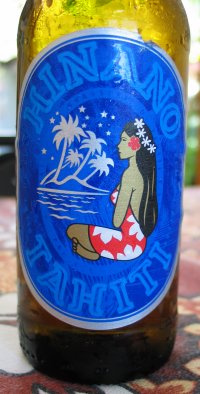 |
|
The anchorage in the Bay of Virgins is surrounded by steep hills forming a bit of a funnel, hence if there is any wind about, it is accelerated through the small gap in the hills and out into the bay. We experienced some severe sustained winds (Gale 8) in the anchorage - sometimes worse than being out at sea - and were luckier than others, who occasionally found themselves having to re-anchor.
|
|
|
All the hills around here are steep! |
|
After about a week in Fatu Hiva we sailed across to the bigger island of Hiva Oa. |
|
One of the joys of French territories - baguettes. |
|
Baie Tahauku, Hiva Oa. |
|
Sue was delighted to find that the town of Atuona had 3 small supermarkets and spent quite a few polynesian francs in them! This is easy to do in French Polynesia as everything is VERY EXPENSIVE here, especially when you have spent the last so many months in South America. Tom's favourite price comparison is with a bottle of beer, and he says that a beer in Venezuela cost about 30 US cents and here in the Marquesas it is about US$3, so there is quite a mark up. |
|
|
Our favourite supermarket provided a free lift back to the harbour in the back of a pick-up truck. We are enjoying the ride with Klaus and Heike from Filia Venti. |
|
|
Sue was even more delighted to find that the shops here stock Twisties. These are an Australian snack food which she has not had for many years, so is now making up for lost time! The shops also sell other favourite Australian products, including biscuits called Tim Tams - the closest British product to these are Penguin chocolate bars, but they pale in comparison to Tim Tams - you will just have to try them for yourselves!
|
|
Old favourites from Oz - yummy! |
|
There are not many birds here, but these little chaps rather catch the eye.
|
|
|
The meeting place, or Tohua Pepeu, is in the centre of Atuona town. It faces onto a small sports field.
|
|
|
|
Some detail of the carvings and thatching in the huts of the meeting place. |
|
|
In Atuona, the main town of Hiva Oa, there is a Gauguin museum which houses not only prints of all of this famous French artist's paintings, but also other artists' versions of his works, including sculptures. Paul Gauguin died in Hiva Oa and his grave is in the cemetery, but unlike many other tourists, we did not go to see it. Allegedly he also tried to commit suicide in Hiva Oa, despite, or perhaps as a result of, having his "Maison du Jouir" (House of Pleasure) here - a copy of this has been reconstructed in the museum garden. |
|
|
Tom taking in the delights of the Gauguin museum.
|
|
|
Tom, desperate to get inside the House of Pleasure. |
|
Above the door of the House of Pleasure it reads: "Be amorous and you will be happy". |
|
While in Hiva Oa, we hired a four-wheel-drive for the day and visited the ancient ceremonial site at Puamau, a 4 hour round trip over dirt tracks. It has several large tikis, including the largest ancient tiki outside Easter island. |
|
|
An unusual lying-down tiki. |
|
|
The big tiki. |
|
The tiki pose. |
|
We stayed in Hiva Oa for the Bastille day celebrations. These started with a "Grande Soiree" on 13 July - an evening of traditional dancing in the sports hall. The hip-wiggling was truly remarkable. |
|
|
Traditional dancing complete with grass skirts and coconut bras. |
|
|
On the day itself, 14 July, there was an early morning parade down the main street of Atuona, some flag-raising and more singing and dancing. When this was done, everyone went down to the park where tables were laid out with food and drink. So we had a second breakfast of cakes and beer, all before 9 o'clock in the morning! The rest of the day consisted of various games, including a lively traditional dance competition in the local beach bar.
|
|
|
Bastille Day parade, Hiva Oa. |
|
|
Traditional headwear. |
|
Polynesian tattoos are an artform. |
|
More tattoos. |
|
More flowers. |
|
The Tahiti Tiare flower. |
|
The Tahiti Tiare flower is a variety of Gardenia and has a fragrance to match. Unusually it can have 6, 7 or 8 petals. It is widely used in floral arrangements, especially for leis and headdresses, but can also be worn singly behind the ear. Wear it behind the right ear if you are free, left for otherwise engaged; open flower for women and closed bud for men. So now you know! |
|
The pool and sun deck in the Hotel Hanakee Pearl Lodge, one of two places in Atuona where we found public access to the internet. Needless to say we didn't just sit at the computer! |
|
|
Also found at the Hotel Hanakee:
Which of these is the door to the Ladies?
|
|
|
|
Just down the road from the anchorage we found Rosie and her extensive garden of fruit, including vanilla which is a member of the orchid family. She sold us wonderful pamplemousse, lemons and bananas. |
|
|
Next day we sailed the 15 miles to the neighbouring island of Tahuata and anchored in the sheltered sandy bay of Vaiehu, alongside a few other yachts. |
|
|
Baie de Vaiehu, Tahuata. |
|
|
We spent the next few days enjoying the peace and quiet, visiting the locals to barter for some fruit, as well as doing a bit of snorkelling. |
|
A local lady preparing a drinking coconut.
|
Sue snorkelling. |
|
Beach BBQ. |
Not unusually when a few cruisers get together, a fair bit of socialising went on, including a beach barbeque with the crews of Nora, Adverse Conditions, Ciel et Mer, Sovereign 2 and Lazy Bones. |
|
Our final island in the Marquesas was Ua Pou, another dramatic skyline of sharp peaks. |
|
|
Baie d'Hakahau, Ua Pou.
|
|
|
Candy Floss is called "Barbe de Papa" here - literally "beard of the father". |
|
Tom admires the solid wood inter-island football trophy while Sue was more taken with the flowery local government office counter. |
|
A beautiful deep pink frangipani and so large too. |
|
The full length (0.5km) of the roadside wall in Hakahau is decorated - far more attractive than just plain concrete and boulders. Must tell the local council back home. |
|
We stayed for a few days taking in yet more traditional dancing, then filled up with water and headed west once more - to the Tuamotus , a group of coral atolls 500 miles southwest. |
